Description
The Ultimate Guide to Beer: Everything You Need to Know
Beer has been a beloved beverage for centuries, with its rich history and wide variety of flavors making it one of the most popular drinks worldwide. Whether you’re a casual drinker or a connoisseur beerexpressisbest, understanding the nuances of beer can enhance your drinking experience. In this comprehensive guide, we’ll dive into the world of beer, exploring its types, brewing process, and how to enjoy it to the fullest.
What is Beer?
Beer is a fermented beverage typically made from four main ingredients: water, barley (or other grains), hops, and yeast. It is the fermentation of these ingredients that gives beer its distinct flavors and alcoholic content. With a history dating back to at least 7000 BC, beer has evolved significantly, creating a vast array of styles and variations.
The brewing process involves extracting sugars from barley or other grains, which are then fermented by yeast to produce alcohol. Hops, the flowers of the hop plant, are added to give beer its signature bitterness, as well as aromas that range from floral to citrusy.
The Different Types of Beer
Beer comes in a variety of styles, each with its own flavor profile, aroma, and alcohol content. Broadly speaking, beers are divided into two categories: ales and lagers. These two types are distinguished primarily by the yeast used and the fermentation process.
1. Ales
Ales are brewed with top-fermenting yeast, which ferments at warmer temperatures. This leads to a faster fermentation process and results in beers with complex flavors. Some of the most popular ale styles include:
-
Pale Ale: Known for its balanced bitterness and fruity, citrusy flavors.
-
India Pale Ale (IPA): A hoppier, more intense version of pale ale with a stronger bitterness and bold hop aromas.
-
Stout: Dark and rich in flavor, stouts often feature roasted malts, chocolate, and coffee flavors.
-
Porter: Similar to stouts, but generally lighter in body and flavor, with a focus on roasted and caramel notes.
2. Lagers
Lagers are brewed with bottom-fermenting yeast, which ferments at cooler temperatures over a longer period. This results in a cleaner, crisper taste with less fruity or spicy flavors. Popular lager styles include:
-
Pilsner: A pale, light lager with a noticeable hop bitterness and a refreshing finish.
-
Bock: A stronger, malt-forward lager with flavors ranging from sweet to caramel-like.
-
Helles Lager: A German-style lager that is malt-focused with a slightly sweet flavor.
The Beer Brewing Process
Brewing beer is both an art and a science. The basic process involves the following steps:
1. Mashing
Mashing is the process of mixing crushed malted barley with hot water to extract fermentable sugars. This mixture, known as “mash,” is then heated to allow enzymes to break down the starches into sugars.
2. Boiling
After mashing, the wort (the liquid extracted from the mash) is boiled and hops are added. Boiling sterilizes the wort and extracts bitterness, flavors, and aromas from the hops. This stage also determines the beer’s color, bitterness, and overall flavor profile.
3. Fermentation
Once the boiling process is complete, the wort is cooled and transferred to a fermentation vessel. Yeast is added to the wort, and fermentation begins. Yeast converts the sugars in the wort into alcohol and carbon dioxide, which is what gives beer its alcohol content and fizz.
4. Conditioning
After fermentation, the beer undergoes a conditioning phase where it is allowed to mature. This period can range from a few days to several weeks, depending on the beer style. During conditioning, flavors mellow, and the beer’s clarity improves.
5. Packaging
After conditioning, the beer is ready to be bottled, canned, or kegged. Some beers are bottled with additional yeast or sugars to promote natural carbonation, while others are carbonated artificially.
How to Enjoy Beer: Pairing with Food
Beer is incredibly versatile and can be paired with a wide range of dishes. Here are some tips for perfect food pairings:
-
Light Beers: Pair light beers like pilsners or wheat ales with salads, seafood, or grilled chicken. Their crisp, refreshing qualities complement light and delicate flavors.
-
IPA: IPAs, with their strong hop bitterness, pair well with spicy foods like Indian or Mexican cuisine. They also work well with rich dishes like grilled meats.
-
Stouts and Porters: The deep, roasted flavors of stouts and porters go great with rich foods like stews, barbecued meats, and even chocolate desserts.
-
Bocks: These malty lagers are great with hearty foods like sausages, burgers, and aged cheeses.
Popular Beer Brands
There are countless breweries producing high-quality beer worldwide. Some of the most iconic and widely recognized beer brands include:
-
Budweiser: Known for its crisp, light lager that has become an American classic.
-
Heineken: A globally recognized pilsner with a distinctive green bottle and a slightly bitter taste.
-
Guinness: Famous for its rich, creamy stout with hints of roasted coffee and chocolate.
-
Sierra Nevada: Known for pioneering the craft beer movement with their distinctive IPAs and pale ales.
The Rise of Craft Beer
In recent years, the craft beer movement has gained significant traction. Smaller, independent breweries are producing innovative and unique brews, often focusing on experimental flavors, local ingredients, and sustainable practices. Craft breweries have contributed to the explosion of beer styles available, from barrel-aged sours to fruit-infused IPAs, making the beer landscape more diverse than ever before.




Reviews
There are no reviews yet.